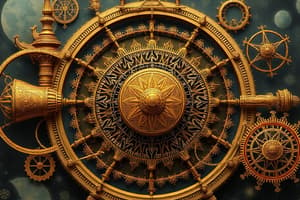Podcast
Questions and Answers
Which of the following scenarios best exemplifies Newton's First Law of Motion?
Which of the following scenarios best exemplifies Newton's First Law of Motion?
According to Newton's Second Law, if the net force acting on an object of constant mass is doubled, what happens to the object's acceleration?
According to Newton's Second Law, if the net force acting on an object of constant mass is doubled, what happens to the object's acceleration?
Which of the following statements accurately describes heat in the context of thermodynamics?
Which of the following statements accurately describes heat in the context of thermodynamics?
Which of the following describes the Zeroth Law of Thermodynamics?
Which of the following describes the Zeroth Law of Thermodynamics?
Signup and view all the answers
According to the Second Law of Thermodynamics, what happens to the total entropy of an isolated system over time?
According to the Second Law of Thermodynamics, what happens to the total entropy of an isolated system over time?
Signup and view all the answers
What is the primary cause of magnetic fields, according to the principles of electromagnetism?
What is the primary cause of magnetic fields, according to the principles of electromagnetism?
Signup and view all the answers
Which law describes the force between two point charges?
Which law describes the force between two point charges?
Signup and view all the answers
Which of the following best describes Faraday's Law?
Which of the following best describes Faraday's Law?
Signup and view all the answers
Which of the following is a direct consequence of the principle of mass-energy equivalence ($E=mc^2$)?
Which of the following is a direct consequence of the principle of mass-energy equivalence ($E=mc^2$)?
Signup and view all the answers
Which of the following phenomena is best explained by General Relativity?
Which of the following phenomena is best explained by General Relativity?
Signup and view all the answers
What is the fundamental concept that differentiates General Relativity from Special Relativity?
What is the fundamental concept that differentiates General Relativity from Special Relativity?
Signup and view all the answers
Which of the following technologies relies most directly on the principles of quantum mechanics?
Which of the following technologies relies most directly on the principles of quantum mechanics?
Signup and view all the answers
Which of the following concepts is a direct consequence of the wave-particle duality?
Which of the following concepts is a direct consequence of the wave-particle duality?
Signup and view all the answers
What is the key difference between reflection and refraction of light?
What is the key difference between reflection and refraction of light?
Signup and view all the answers
What is the central idea behind the uncertainty principle in quantum mechanics?
What is the central idea behind the uncertainty principle in quantum mechanics?
Signup and view all the answers
Which of the following best describes the phenomenon of diffraction?
Which of the following best describes the phenomenon of diffraction?
Signup and view all the answers
Flashcards
Newton's First Law
Newton's First Law
An object remains at rest or in motion unless acted upon by an unbalanced force.
Newton's Second Law
Newton's Second Law
Acceleration is directly proportional to net force and inversely proportional to mass (F = ma).
Newton's Third Law
Newton's Third Law
For every action, there is an equal and opposite reaction.
Zeroth Law of Thermodynamics
Zeroth Law of Thermodynamics
Signup and view all the flashcards
First Law of Thermodynamics
First Law of Thermodynamics
Signup and view all the flashcards
Second Law of Thermodynamics
Second Law of Thermodynamics
Signup and view all the flashcards
Electromagnetism
Electromagnetism
Signup and view all the flashcards
Coulomb's Law
Coulomb's Law
Signup and view all the flashcards
Maxwell's Equations
Maxwell's Equations
Signup and view all the flashcards
Special Relativity
Special Relativity
Signup and view all the flashcards
Time Dilation
Time Dilation
Signup and view all the flashcards
Length Contraction
Length Contraction
Signup and view all the flashcards
Mass-Energy Equivalence
Mass-Energy Equivalence
Signup and view all the flashcards
General Relativity
General Relativity
Signup and view all the flashcards
Wave-Particle Duality
Wave-Particle Duality
Signup and view all the flashcards
Diffraction
Diffraction
Signup and view all the flashcards
Study Notes
Classical Mechanics
- Classical mechanics describes the motion of macroscopic objects at low speeds.
- It's based on Newton's laws of motion and the concept of forces.
- Newton's First Law: An object at rest stays at rest and an object in motion stays in motion with the same speed and in the same direction unless acted upon by an unbalanced force.
- Newton's Second Law: The acceleration of an object is directly proportional to the net force acting on it and inversely proportional to its mass. (F = ma)
- Newton's Third Law: For every action, there is an equal and opposite reaction.
- Concepts like inertia, momentum, and energy are central to classical mechanics.
- Applications include predicting the trajectories of projectiles, analyzing the motion of planets, and designing machines.
Thermodynamics
- Thermodynamics deals with heat, energy, and temperature.
- It describes how these quantities change and influence systems.
- Key concepts include:
- Temperature: A measure of the average kinetic energy of particles in a substance.
- Heat: The transfer of thermal energy between objects at different temperatures.
- Internal Energy: The total energy stored within a system.
- Work: Energy transferred to or from a system via a force acting through a distance.
- Laws of Thermodynamics:
- Zeroth Law: If two systems are each in thermal equilibrium with a third system, they are in thermal equilibrium with each other.
- First Law: Energy cannot be created or destroyed, only transferred or changed from one form to another.
- Second Law: The total entropy of an isolated system can only increase over time. Heat cannot spontaneously flow from a colder to a hotter object.
- Third Law: The entropy of a system approaches a constant value as the temperature approaches absolute zero.
- Applications are widespread in engineering and other sciences.
Electromagnetism
- Electromagnetism describes the interaction between electric and magnetic fields.
- Electric fields are created by stationary or moving electric charges.
- Magnetic fields are created by moving electric charges.
- Key concepts include electric charge, electric field, magnetic field, electric current.
- Coulomb's Law describes the force between two point charges.
- Faraday's Law describes electromagnetic induction (a changing magnetic field induces an electric field).
- Ampere's Law describes the relationship between a magnetic field and the electric current that produces it.
- Maxwell's equations summarize the fundamental laws of electromagnetism.
- Applications include electric motors, generators, and various electronic devices.
Relativity
- Relativity describes the relationship between space and time.
- Special Relativity: Addresses the motion of objects at constant velocities and the implications for space and time.
- Key postulates of Special Relativity:
- The laws of physics are the same for all observers in uniform motion.
- The speed of light in a vacuum is the same for all observers, regardless of the motion of the light source.
- Consequences of Special Relativity:
- Time dilation: Time passes slower for moving objects compared to stationary objects.
- Length contraction: Moving objects appear shorter in the direction of motion.
- Mass-energy equivalence (E=mc²): Energy and mass are interchangeable.
- General Relativity: Explains gravity as a curvature of spacetime caused by mass and energy.
- Key concepts are warped spacetime, geodesics, gravitational time dilation.
- Applications include GPS systems, understanding black holes, and cosmology.
Quantum Mechanics
- Quantum mechanics describes the behavior of matter and energy at the atomic and subatomic levels.
- Key concepts:
- Quantization of energy: Energy can only exist in discrete values (quantized).
- Wave-particle duality: Particles can exhibit wave-like properties and vice-versa.
- Uncertainty principle: There is a fundamental limit to the precision with which certain pairs of physical properties of a particle can be known simultaneously.
- Quantum phenomena are often counter-intuitive to classical descriptions and are understood using probabilistic models.
- Applications include the development of transistors, lasers, nuclear power, and understanding the structure of matter.
Optics
- Optics describes the behavior of light.
- Key concepts include:
- Reflection: Bouncing of light off a surface.
- Refraction: Bending of light as it passes from one medium to another.
- Diffraction: Spreading of light as it passes through an aperture or around an obstacle.
- Interference: Combining of light waves with each other to produce brighter or darker regions.
- Applications of optics include lenses, mirrors, telescopes, microscopes and fiber optics.
Studying That Suits You
Use AI to generate personalized quizzes and flashcards to suit your learning preferences.
Description
Test your understanding of classical mechanics and thermodynamics through this quiz. Explore the fundamental laws of motion, the principles of force, and the basics of heat and energy transfer. Challenge your knowledge of Newton's laws and thermodynamic concepts.




